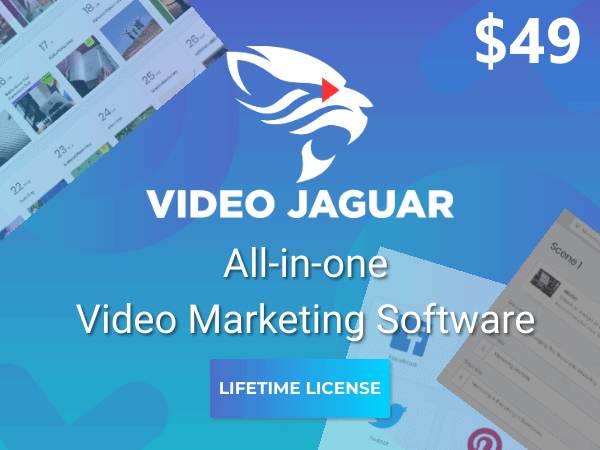Essential Video File Types You Need for Marketing Success
Video Jaguar -
Video Creation Software
Lifetime License Deal
What File Types Do I Need For Video? A Guide for Marketing and Advertising Professionals
As a marketing and advertising guru, understanding the various file types for video content is essential for creating compelling campaigns. With the proliferation of digital platforms, using the correct video file format can make a significant difference in audience engagement, loading times, and overall quality. Here’s a comprehensive guide to the most commonly used video file types and their best applications in the marketing realm.
1. MP4 (MPEG-4 Part 14)
Overview:
MP4 is arguably the most widely used video format across platforms. It combines video, audio, subtitles, and still images in a single file.
Advantages:
- Compatibility: Works on almost all devices and platforms, including social media, websites, and mobile applications.
- Quality and Compression: Offers a good balance between quality and file size, making it ideal for online streaming.
- SEO Friendly: Search engines can index MP4 files, potentially boosting visibility.
Ideal Uses:
- Social media posts (Facebook, Instagram, Twitter)
- Website videos (embedded content)
- Email marketing campaigns
2. AVI (Audio Video Interleave)
Overview:
Developed by Microsoft, AVI files offer high-quality video at the expense of larger file sizes.
Advantages:
- Quality: Supports high-resolution video formats, making it ideal for editing.
- Audio and Video Sync: Provides excellent audio-visual synchronization.
Limitations:
- File Size: Larger file sizes can lead to longer loading times, making it less suitable for online use.
Ideal Uses:
- Video editing tools
- Local playback on personal computers
3. MOV (QuickTime Movie)
Overview:
Created by Apple, MOV files are commonly used for high-quality video playback and are ideal for Macs.
Advantages:
- Quality: Offers high-quality video that supports multiple codecs.
- Editing-Friendly: Great for use in video editing software, especially in professional environments.
Limitations:
- Compatibility: Can be less compatible with non-Apple devices, requiring additional software for playback.
Ideal Uses:
- Professional video editing
- High-quality presentations
4. WMV (Windows Media Video)
Overview:
Also developed by Microsoft, WMV files are designed for Windows platform playback.
Advantages:
- Compression: Highly compressed, leading to smaller file sizes without severe loss in quality.
- Streaming: Optimized for web streaming capabilities.
Limitations:
- Compatibility: Primarily designed for Windows environments, potentially causing issues on other platforms.
Ideal Uses:
- Internal corporate videos
- Windows-based playback
5. FLV (Flash Video)
Overview:
Historically popular for online video streaming, FLV files are used by Adobe Flash Player.
Advantages:
- Streaming Efficiency: Efficient for streaming video content over the internet.
Limitations:
- Decreasing Popularity: Many platforms are transitioning away from Flash, making FLV less viable.
Ideal Uses:
- Legacy projects that still rely on Adobe Flash.
6. MKV (Matroska Video)
Overview:
MKV files are multimedia containers that can hold an unlimited number of video, audio, and subtitle tracks.
Advantages:
- Versatility: Supports a wide range of codecs and is often used for high-definition online video content.
- Quality: Retains high quality at lower file sizes.
Limitations:
- Compatibility Issues: Not all devices support MKV format natively.
Ideal Uses:
- High-definition video distribution
- Online film festivals and digital cinema
Conclusion
Choosing the right video file type is critical for marketers and advertisers seeking to maximize their content’s reach and engagement. Whether you are aiming for seamless social media integration, high-quality presentations, or editing capabilities, understanding the strengths and limitations of each format will empower you to make informed decisions. By selecting the appropriate file type, you can ensure that your video content meets audience expectations, excels in search visibility, and enhances your overall marketing efforts.
In a fast-paced digital landscape, investing the time to understand and correctly implement these file types will undoubtedly pay off in the effectiveness of your campaigns.
CREATE MARKETING VIDEOS:
EXPLORE VIDEO MAKERS:
The post Essential Video File Types You Need for Marketing Success appeared first on Video Jaguar.
from Video Jaguar https://ift.tt/jVDPLns
via Video Marketing Blog

Comments
Post a Comment